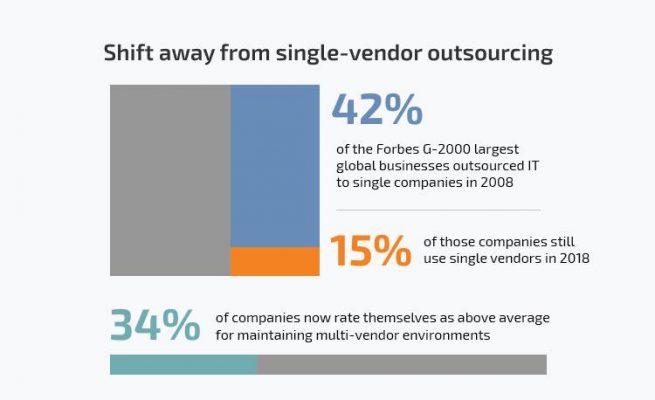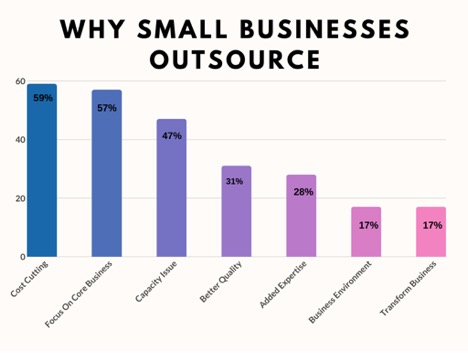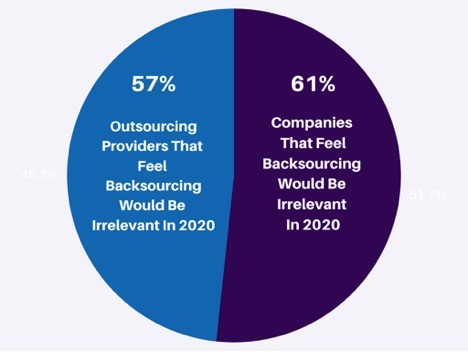There are certain trends that are expected to take a complete turn after the lockdown. And digital transformation or business automation will be a popularly-adopted strategy. Outsourcing, especially automation outsourcing, has been completely shaken up. For enterprises to ride the wave of change and emerge on the other side, shifting gears today with the latest outsourcing practices is imperative.
Contents
Key Takeaways
- The outsourcing industry will transform this year with a major emphasis on building value networks with outsourcing companies.
- Co-sourcing will become the new norm as businesses choose to support each other and share the risks.
- SMBs and startups will be the ones offering more business to outsourcing service providers.
- The majority of the firms will shy away from back-sourcing and rely on outsourcing for the long run.
- There is a new kind of outsourcing practice called outcome-based outsourcing as companies look for service integrators instead of service providers.
- Dominating outsourcing countries face challenges from countries like Poland, Romania, Belarus, etc.
- New digital execution approaches will be created by the outsourcing companies to integrate strategies across digital platforms.
Emphasis on building relationship networks has strengthened
Programming companies have been moving toward digital transformation and so has the outsources industry. By the end of 2020, we can hope to see a shift from the traditional value chain to a more flexible and scalable value network.
In fact, building value networks has become a priority for many businesses in 2020. But what does value network mean in outsources?
Value networks are connections you build to create value for your company or its processes. A value network in outsources would mean building a network of meaningful relationships. Or contracts with outsourcing companies in India, China, Ukraine, or any other country (even your home country) to add value to the outsourced or outsourcing services.
You can expect to see different types of relationship networks.
- A purchasing network, where two or more firms will come together to leverage outsourced services for saving costs
- A service provider network, where different outsourcing service providers will come together to meet the complex demands and challenges
- A single enterprise might also look to hire remote developers from different service providers in order to improve their outcome.
Growing inclination toward co-sourcing
Outsourcing is a buyer-centered market. The buyer, (the company taking outsourcing services), identifies all its requirements in an RFP. The seller, (the outsourcing company), feels it can fulfill the requirements and bids for the work. The price, tenure, team, technology, skills, everything is proposed per the requirements of the buyer. The services are for the buyer and so are the risks associated with it.
But studying the trends in outsourcing for the past few months and analyzing the current global situation, it is clear that the focus is moving from just cutting costs to mitigating the risks associated with outsourcing. And based on the way the outsourcing commitments are taking shape, a new approach is emerging—an approach that focuses on creating value for both the companies. We call this approach “co-sourcing.”
What is co-sourcing?
This is an approach where companies hire an external team that acts as their internal team and the two parties work in collaboration. Both the internal and external teams work together, side-by-side to create value. Together, they share the risks, face issues, and come up with quick solutions.
Motivating both the parties, co-sourcing will help improve the system outcome achieved from outsourcing. This approach vests their interests in co-creating new values to gain a competitive edge. Even during unrest, they can easily go through their contract and ensure that the work is not hampered. Their interests will be focused on the outcome of the collaboration and not in either completing the task for the client or just delegating a task for completion.
The programming sector is erupting with new advanced digital products created by two organizations coming together from different parts of the globe. They can delegate the development of their most important integration projects, enterprise architecture, or other core competencies to the external team while keeping the management at their end. More focus is on delivering a product that delivers profits for both parties.
SMBs and startups to create more business
Studying the trends in outsourcing so far, it becomes clear that the digital transformation, fueling programming outsource, is predominantly supported by large scale enterprises. However, taking a look at the number of small businesses and startups blooming, we realize that major business coming from this startup economy is reaching the outsourcing companies.
Small businesses have moved toward outsourcing a majority of their processes in order to cut costs, focus on core business, resolve capacity issues, get better quality, and much more.
Here are some numbers that show this trend.
- A study by Clutch reveals that over 37% of small businesses outsourced their business processes in 2018 and over 52% have outsourced development to India in 2019. As outsourcing helps them increase efficiency and get expert assistance, more small businesses are shifting to outsourcing in 2020.
- The startup economy topped the $2.8 trillion economic value mark and more entrepreneurs are ditching their 9 to 5 jobs to profit from this lucrative market. But over 29% face a cash crunch within a year. Keeping up with the startup’s funding requirements and paying the employees to offer state-of-the-art services will pose a challenge. Their attention will easily diverge to setting up remote tech teams or hiring dedicated teams for their business operations.
In the coming years, outsourcing companies can expect to get more business out of the booming startup economy. And the burgeoning number of small and medium-sized businesses. As more startups are coming up with new digital solutions and small businesses are shifting toward enhancing the digital experience they offer, companies offering programming services can expect more business. In fact, the sudden boom in digitization has caused the SMBs that are in the prototyping stage to push their products forward for quick launch.
Backsourcing loses most significance
For a majority of the companies, an outsourcing business plan always concludes with backsourcing. Before throwing light on how backsourcing will dissolve, let’s learn what it actually is.
Backsourcing is the process where organizations bring the outsourced tasks back to in-house development teams. Many companies, especially startups, questioned how far outsourcing could take them.
This practice became popular in the initial phase of 2020, when the pandemic took a larger form. However, as soon as companies realized that this would become the new normal, the practice of backsource is expected to lose significance soon.
The only companies that have been successful with outsourcing are the ones with architectural knowledge. Reversibility in the outsourcing path, leading to successful backsourcing, is possible only if a firm is able to adopt increased modularity in its functionalities. But as this requires more capital and technological capabilities on the firm’s end, transitioning back to insourcing is losing significance. Thus, backsourcing is no longer seen as a very successful approach.
“61% of companies thought backsourcing will be less significant in 2020, with 57% of outsourcing service providers saying the same,” claims the National Outsourcing Association’s “Outsourcing in 2020” survey results.
This is a clear indication that companies are planning to continue with their outsourcing relations for the long-term instead of just outsourcing for a particular time. As outsourcing brings in more efficiency in tasks while reducing the costs, backsourcing will rightly become less significant in 2020.
However, this global pandemic might have altered this trend. As the majority of the countries are under complete lockdown, many companies are repatriating services for the short term to plug the gaps. As the question of business continuity looms over all businesses, in the coming times, businesses would form new recovery plans to combat such disastrous situations.
Outcome-based contracting to gain prominence
The next thing that could change in the outsourcing market in 2020 is the basis on which outsourcing contracts are formed.
Instead of the traditional project, technology, price, or time-based contracting, we will see a shift toward more outcome-based outsourcing.
Companies are becoming more aware of the risks and instead of creating an output-based contract, they will now be forming outcome-based contracts. This kind of outsourcing will not just mitigate the risks for the outsourcing buyers, but also motivate the outsourcing service providers by sharing rewards.
Companies will approach service providers as service integrators. Who will not just complete the project but also share the risks and rewards for a more value-driven delivery. Companies will also benefit from such a contract as it will allow them to get an in-depth assessment of the possibility of any future outsourcing relations.
New competitions to arise in outsourcing
Seeing the outsourcing trends in the past year, it is clear that many countries are fighting to take this spot. The same benefits are being offered by many other countries.
Take the case of Ukraine—presently it has over 166,000 software developers and the number is expected to increase to 250,000 by the end of 2020. No wonder we will see the country rising as a bigger competitor for India, China, and other leading countries.
What can the automation companies expect from this trend?
When competition grows, companies in each country try to gain an edge. Be it by offering better quality, lowering the prices, or adding other benefits, companies seeking programming services can benefit from this competition.
Moreover, with many countries under lockdown, organizations outsourcing their business operations to other countries are facing challenges in ensuring business continuity. This is shifting their attention to countries that are not so severely affected by the pandemic. Thus, these countries will emerge even stronger in the post-pandemic normal.
The emergence of a digital outsourcing model
The current outsourcing model includes services offered by people and powered or supported by tools.
In the coming years, the expected outsourcing model will have services offered by digitally automated tools. And the role of people will be limited to controlling these tools.
The outsourcing model so far is based on the services provided by people and supported by tools. But this traditional model has already started to break apart. A more digitally-inclined model is taking form. Where services are offered by digital tools and the ones supporting the efficient working of these tools are people.
Robotic process automation, software bots, automation, machine learning. And other disruptive technologies are becoming ubiquitous and taking over the world. The outsourcing industry will also be affected by it. A new digital approach will emerge.
This will encourage outsourcing companies to create new digital execution strategies, maintain digital systems. And integrate these strategies across various digital platforms. Many of the emerging techs like virtualization and grid computing are also enabling the innovators in the outsourcing industry to utilize the standardized infrastructure.
New approaches for post-pandemic transition
As businesses are faced with an unprecedented situation, managing offshore teams could be a challenge. With the majority of the employees moving their workstations home, there has been a confluence around the security of projects and setting up VPNs. This has caused businesses to go through their outsourcing contracts once again, set-up new pointers for WFH, etc.
The current response by most CEOs, and other organization leaders is to resolve the issues at hand and build resilience to combat what’s coming in the post-pandemic normal world. Here are some of the approaches that we might expect business leaders to follow next to emerge stronger after the pandemic in regards to their outsourcing practices:
- Install real-time dashboards to monitor the work being done at the outsourced company and track each metric.
- Include disaster mitigation strategies in the outsourcing contract to ensure smooth work in case a similar situation erupts in the future.
- Adopt a business automation approach to reduce human capacity. The focus might shift to building an advanced working model based on emerging technologies.
- Shift to critical business projects and reallocating resources to projects that are high priority.
- Address information security as a serious concern regarding intellectual property theft.
- Consider cloud migration as the new norm in the coming times.
Putting it in a nutshell…
Outsourcing has been empowering companies to get more tasks completed at a lower cost since the 1980s. However, the way businesses got their work done then, (with fewer technologies and less to no internet), is very different from how companies outsource today. The technologies have evolved and practices have changed—and this change is constant.
In 2020 as well, we are witnessing new outsources practices .Like co-sourcing, outcome-based outsourcing and others that have been discussed above.
Learn more about automation programming at CTI Supply. We are providing automation service with well-qualified engineers.


 Tiếng Việt
Tiếng Việt


